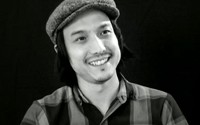Andy Kehoe Turns Dreams into Fantasies
By David Jenison
“I inhabit my worlds with strange creatures and like many of the subjects in Romantic paintings, they are often dwarfed by the nature surrounding them,” says Andy Kehoe, a Pittsburgh-based artist whose mixed-media works commonly feature animal-human hybrids in dark forests and moody landscapes. While influenced by the 19th century Romanticism movement, Kehoe admits his vivid, other-worldly dreams also inspire the images he paints. The artist’s most recent show, Fantastical Romanticism at the Jonathan LeVine Gallery in New York, includes emotive pieces produced using various combinations of oil, acrylic, resin and polymer clay on cradled wood panels. PRØHBTD spoke with Kehoe to learn more.
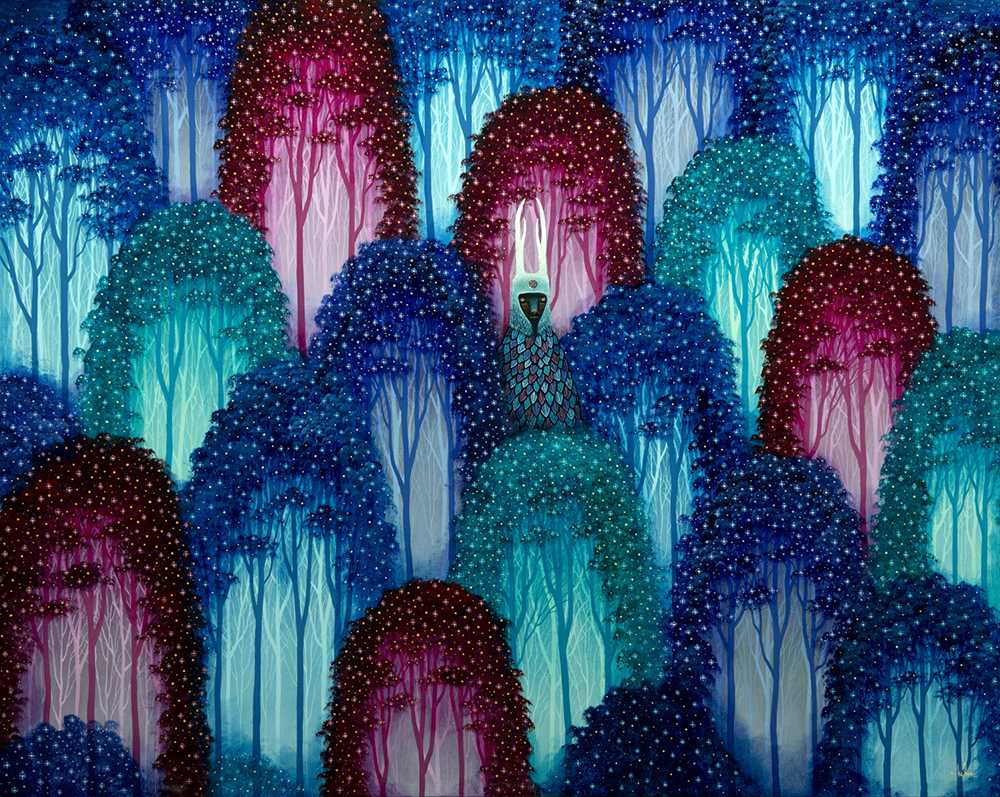
What can you tell me about your exhibit at Jonathan LeVine? In what ways did you challenge yourself?
Every show is a challenge unto itself. One of the overarching challenges is to keep evolving and moving forward while maintaining the essence of what initially drew people to your work. Luckily, I feel that I work in a theme and a medium that allows me to keep experimenting and working outside of my comfort zone. Though there are some stressful moments involved in working in this manner, it’s always exciting to jump headlong into uncharted waters and see what comes of out trying something new.
For this show in particular, I had a lot of ideas that felt like they needed room to breathe. I was particularly inspired by the Romantic Period of painting so that meant grandeur and huge emotional impact. That also meant going big… well, big for me. Three feet is big in my book, especially with the resin layers. Beyond the Familiar is the biggest piece I’ve ever done using resin, so I wanted that one to be extra special. I had some more complicated concepts in mind for that piece, but in the end, I went with a pretty simple composition. There’s a lot going on technically, but spatially and in the color scheme, it’s a pretty minimal composition. Of all of the pieces in the show, I was most nervous about that one. It’s a bit of a departure for me in many ways, but I felt like it touched on common themes and possessed the emotional resonance that I hope is prevalent in all my work.
I also wanted to continue to expand my color palette a bit and play around with some color gradients. I’ve been broadening my color scheme with each show, and this show is kind of the culmination of that endeavor. Though withThe Hunter, I wanted to bring back a true Autumnal color palette to harken back to my older work.
Additionally, I wanted to do some straight oil and acrylic paintings again. There are definitely things I miss about doing more traditional paintings, such as the ability to go back and work on the background again. With the resin, once that layer of resin is poured, you can only move forward. Which is both liberating and horrifying. After all these years of doing the resin pieces and working in pronounced layers, I was curious to see how that process would influence my painting process. It really took me a while to get back in the swing of it, but I really enjoyed it. I think I’ll definitely be doing more in the future.
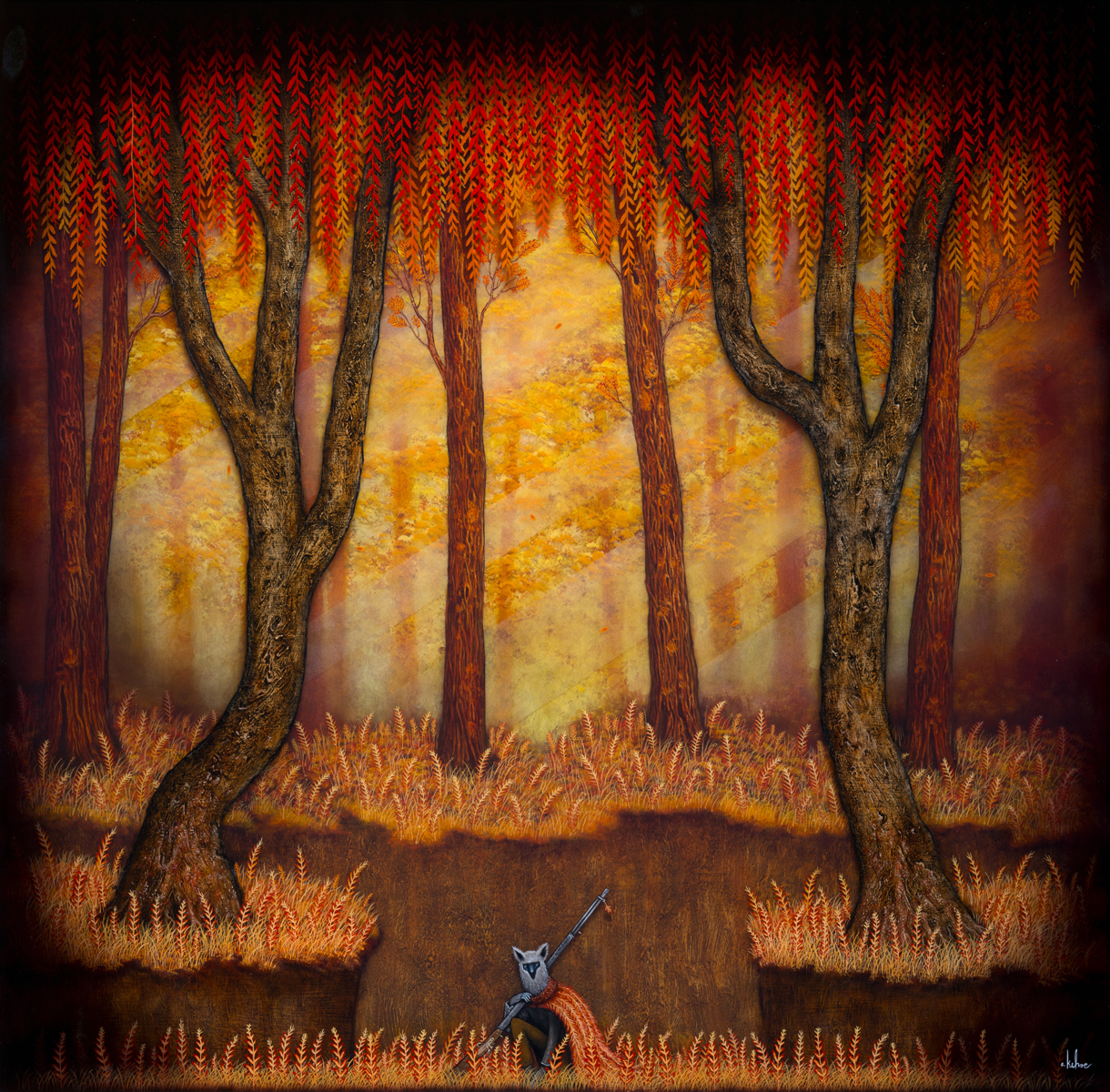
Do you see your art as a dream, an alternate reality or possibly the future?
I don’t see my work as a dream, but some of my pieces are definitely inspired by my dreams. I love my dreams. I have crazy, amazing dreams. Some of them are straight-up action dreams full of explosions, gun fights and narrow escapes. I’ve had numerous end-of-the-world scenario dreams where something hugely catastrophic occurs, and it’s simultaneously horrifying and awe inspiring. I also have a reoccurring dream where I’m standing on a snowy, barren, stony shore overlooking a vast, empty, silent ocean. It feels as far away as you can get, and I can smell the clean, salty air and feel the crispness of it on my skin. I don’t know what it is or where it is, but it brings me equal measures of placidity and fear of being so far removed from the rest of the world. That specific feeling has definitely made it into my work, but I have yet to attempt the image of it.
Most of all, though, I go on journeys and see strange and wondrous places in my dreams. I always tell my wife that I wish I could record the imagery I see when I dream so I can show her these amazing landscapes and wonders. I want to share the unexplainable emotion that it evokes. In that sense, the best I can do is try to emulate the imagery and the correlating feeling in my work. One work in the show that was directly inspired by my nightly adventures isDreamscape Wanderer. I see this creature as a sort of dream psychopomp that guides me to both familiar and unexplored dreamscapes. The subconscious can be a labyrinthine place, so it’s good to have someone there to help you along.
As for the actual world in my art, I see it as a conflux between many different worlds and realities, and the separation between the different planes of existence is pretty thin. This leads to worlds bleeding into each other and creatures inadvertently crossing over into this world. A multi-universal melting pot of alternate realities with the creatures and cultures that go along with them. There are also ancient creatures that have always lived in this world, as well as creatures that can travel between the worlds.
Our own reality is included in this, which is why you see little bits of human influences scattered around. This is definitely not an alternate version of Earth. Earth is a place where virtually all magic has been stripped from the world, save the traces that can still be found in the minds of more imaginative beings. This other world is a place where the magical and supernatural are unequivocally real, and part of the very fabric of the reality. When humans migrate to this world, they bring the best and worst of humanity with them. They change when exposed to a world infused with magic and, in part, create some of the best and worst aspects of the world. Thus is human nature.
Most of the time the layers of the alternate planes are hidden from view, but there are places where different worlds come into plain sight. In the piece Multiversal Coalescence, the character is overlooking a valley where multiple universes are materializing and converging in a visible way.
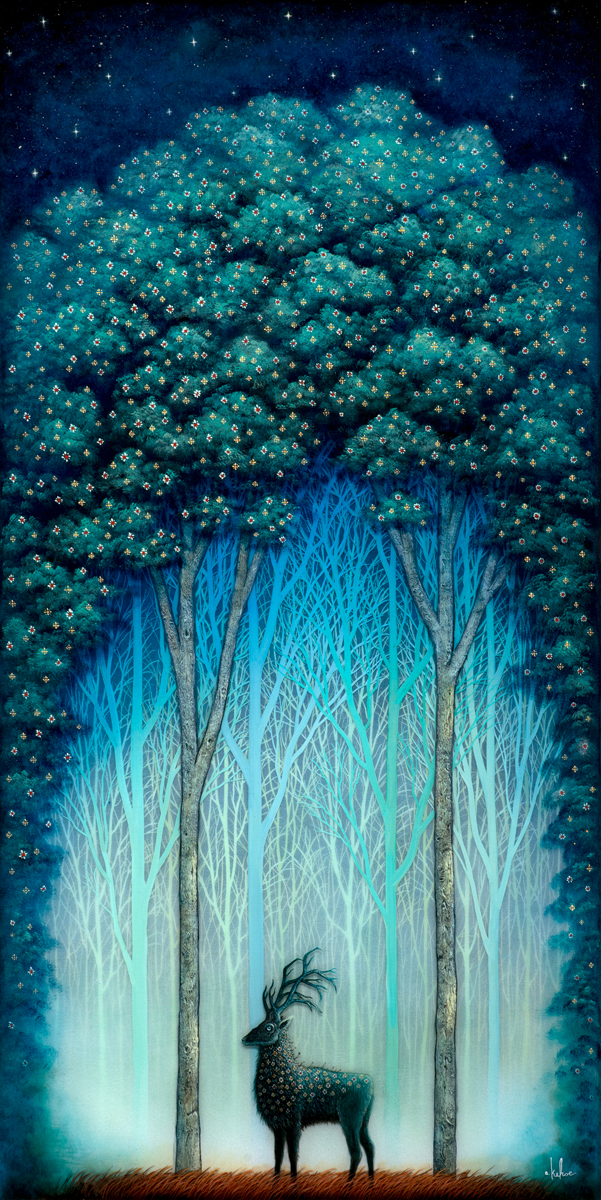
Your art commonly places animals, creatures and human-animal hybrids in natural settings like a forest. What does the forest symbolize for you?
The forest symbolizes so much to me such as mystery, disorder, exploration, discovery and the unknown. It’s been a mythical place throughout our human history, and it’s no different for me. So many of the fairy tales and folk stories I read growing up take place deep in the woods with the dangers and wonders held within.
It’s an uncivilized, organic mess of chaos that exists completely outside our normal measures of control and order. There is a certain power in entering a place that doesn’t adhere to the laws of mankind. The edge of the forest is literally a threshold to a different world, and when you cross that threshold, you are stepping inside a giant living structure.
I’ve always held a certain reverence for the forest. When we were young, my twin brother Ben and I used to run around the woods behind our house any chance we could. We had an amazing stretch of forest to explore full of streams, tree bridges, vines to swing on and lots of critters to observe. It always felt like a sacred place, but one that I didn’t belong to no matter how wild I tried to act. It’s a similar feeling I have when I step into a mosque or a cathedral. All I can do is appreciate the immense beauty and wonder of it because I’ll never truly be a part of it.

In terms of the characters, what do they say about the line between humans and animals?
Since this is a meeting place of worlds, the line between animals and more humanoid creatures is very vague. Many of the creature’s characteristics are based on where they came from and how they’ve adapted and evolved to the world around them. There are creatures that have always been denizens of this world, and they are the most ancient and beast-like. The characters change the world around them to a degree, but it’s mostly the environment that changes them.
All the creatures grow up and live in this untamed environment, and for the most part, there isn’t the desire to tame and conquer the wilderness. It’s more of a synergistic relationship, especially with the ancient creatures. They are a product of their surroundings, and many of the creatures are comprised of the flora and nature around them. Their environment is part of them in a very literal sense.
A good example of this is the piece Sacred Beast.
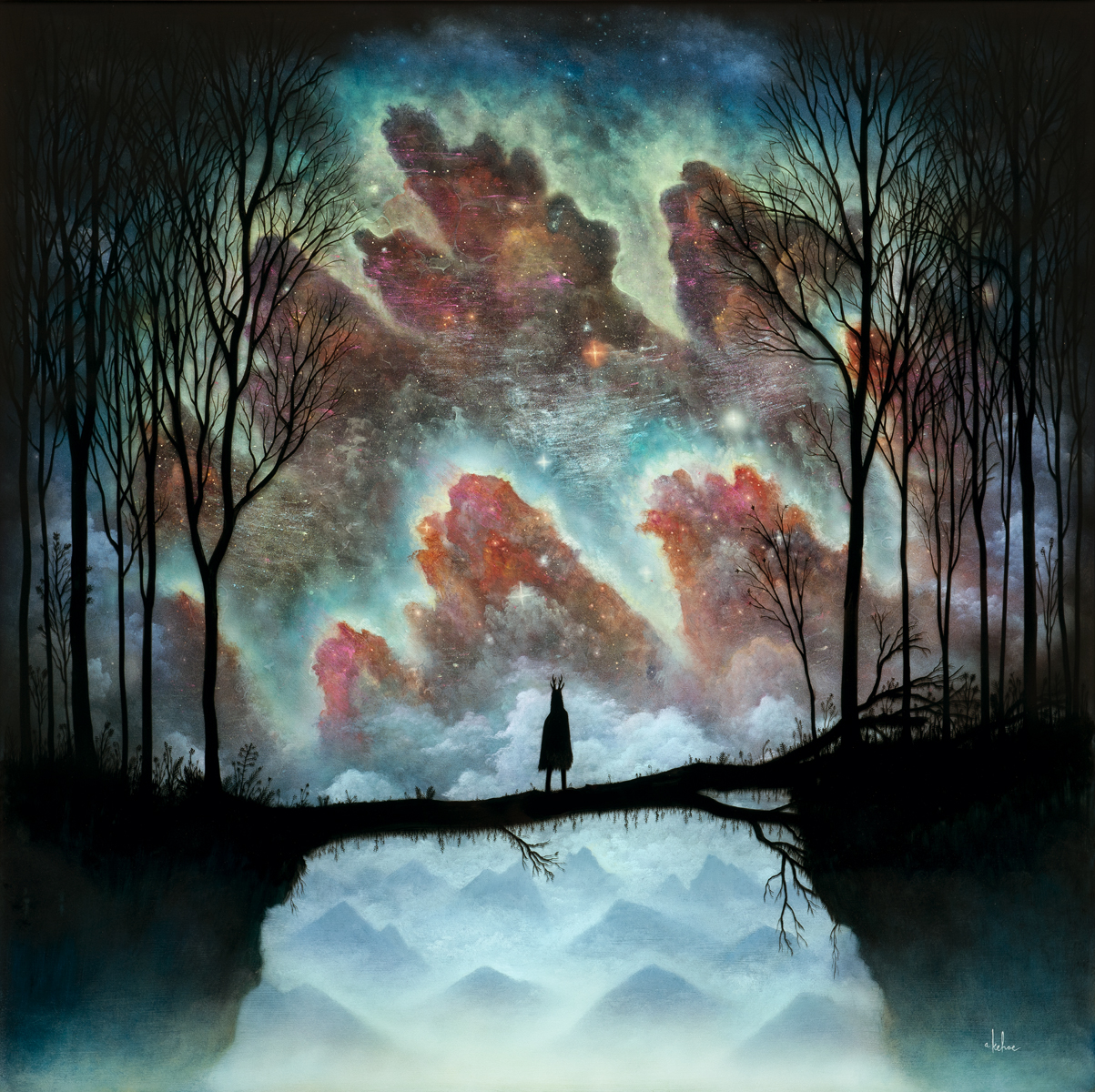
What type of energy does your artwork tap into in terms of the imagination and possibility?
Imagination is paramount for me, and one of my goals is to create a world where anything is possible. For as much as I’ve gone into my reasons for why my world is the way it is, I want to create an energy that inspires the viewer to tap into their own imagination and create their own stories from the imagery I’m providing. The emotional response of the work has always been more important than the specific narrative.
Do you consider your artwork to be dark, and if so, what are the positive aspect of darker themes?
There’s definitely a note of darkness in my work, but I feel like there is a beautiful mystery to darkness. When I think of all the movies and stories that really affected me growing up, they all had dark moments in them. Movies like The NeverEnding Story, The Secret of NIMH, Willy Wonka—that tunnel scene used to scare the crap out of me—The Dark Crystal and Labyrinth all had moments of real dread and consequence in them that simultaneously frightened and fascinated me. I doubt those movies would have stuck with me over all these years without those moments.
Darkness is more complicated and ambiguous in its nature than our very pronounced notions of goodness and uprightness. That in itself makes it undeniably interesting. But in reality, there are very few people and very few actions that are starkly one or the other. I prefer to tow the line with my work, and have dark and light coexisting with each other.

Is there anything that helps you get outside the present reality when coming up with ideas for your art?
When it comes to brainstorming, I usually retreat to my studio, put on some sort of weird, ambient music in my headphones and stare at the piece I’m working on. This happens at every stage of painting. In the very beginning, I’ll stare at blank panels for inordinate amounts of time until the idea begins to work itself out a bit. There’s something about seeing the working surface that helps me to further visualize the concept… even when that surface is nothing more than blank gesso.
When I get further in the piece, I’ll sit with it again and reassess my starting concept with the current state of the painting. Many times when the world starts coming together, I’ll change up character placement and sometimes change their scale to better fit their environment. Sometimes the original concept changes completely when I imagine something else existing in the environment.
These moments are actually very important to me and my creative process. I try to never be too stringent with a starting concept, and I allow for the concept to grow and change organically as the painting progresses. Working with layers built up with resin slows the whole process down and gives me time for these moments of reflection.
Most of my ideas come out of these sessions, and at this point, I’m not even too sure where my ideas come from anymore. So many of these ideas are very abstract and very much from the subconscious. The piece Nascent Musings of Incorporeal Designs deals with bringing these unformed concepts out of the ether into something tangible.
Originally featured on PRØHBTD




